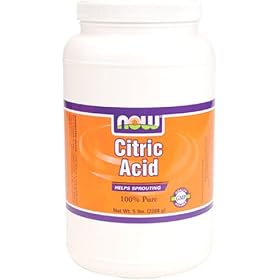The first thing I ever read about cheese making was how sterile everything needed to be. I have to say that turned me off for a lot of years. I finally decided to give it a whirl, sterile environment or not. Nothing in my house is sterile. Even if I bleach things or sanitize them in the dishwasher, as soon as they come out they are no longer sterile. But neither were the farm kitchens of a hundred years ago, and they managed to make cheese. So as clean as I can get it is good enough. At least for Mozzarella and Ricotta.
Make a gallon of milk using 15 -16 cups of water and 5 ½ cups milk powder

This will (of course)give you a fat free cheese. It doesn't quite melt the same way as full fat water buffalo milk mozzarella. You can add fat to it by adding a pint of cream to the milk or a couple of sticks of melted butter.
Mix 1 ¼ tsp citric acid powder with ½ cup of water. Stir into milk.

Heat milk to 88 degrees
This is rennet. You can find it by the jello in the grocery store

Inside the box are 8 (I think) little foil wrapped tablets.
For this recipe you will need 1/2 a tablet. Break one disk of rennet in half and dissolve it in ¼ cup of water.
Now for the tricky part: let this mixture sit undisturbed for a LONG time.
Traditional recipes say 1-2 hours, but powdered milk takes longer. At least 5, but I have had great luck with overnight.
This is what the coagulated curd looks like after 6 hours or so.

It is pretty soft and not what you would call a clean break. You can get it to clean break status by letting it sit longer (like overnight). For a great picture of what "clean break" means zip over here: clean break picture and discussion
Incidentally, I have made mozzarella cheese when it has only gotten to the coagulated stage (pictured above) and when I have waited the 18 hours to get it to a clean break. I didn't notice any difference between the finished cheeses. Perhaps it is just something about using powdered milk with no extras.
Oh! and on another side link over here for a discussion about how to use powdered milk to make cheese. This was my jumping off point, but I couldn't find all the extra stuff they needed, so I just started to wing it and it seems to work. At least for mozzarella and ricotta.
I recommend a thorough reading of both of these sites, but in the end, just jump in and try, because it is not as complicated as either one makes it seem.
Cut the curd.
Again, link to that first web page and there is a great picture of how to do that. Basically, you run a long knife down to the bottom of the pot making inch long strips in one direction, then do it in the perpendicular direction. Then if you want to cut at a 45 degree angle in the pot you can do that too.
Over low heat, stir curds and whey gently.

As the temperature rises to about 100 degrees the curds will start to solidify and separate more from the whey
The curds and whey will start to really separate and the curds will melt and clump together like so.

This will take about an half an hour.
Strain the curds through a few layers of cheese cloth or a clean tea towel.

SAVE THE WHEY!
It looks like this.

You will turn this into ricotta tomorrow. (Oh, yes you will!)
Salt your curds. 1 TBS salt, well mixed in.

I always forget this step and it makes the cheese taste really rather bland.
Now, for making the cheese into balls. It is another 2 handed project so no pictures. But scroll down for a video of how some other guy does it.
Put about 1/3 of the curds into a microwave safe bowl.
Microwave for about a minute or so (until the cheese melts.) Be careful! It is hot!
Next stretch the cheese into a smooth round ball like a loaf of bread.
Put the finished ball into a bowl of cold water to solidify.
Best step: use your cheese!




















